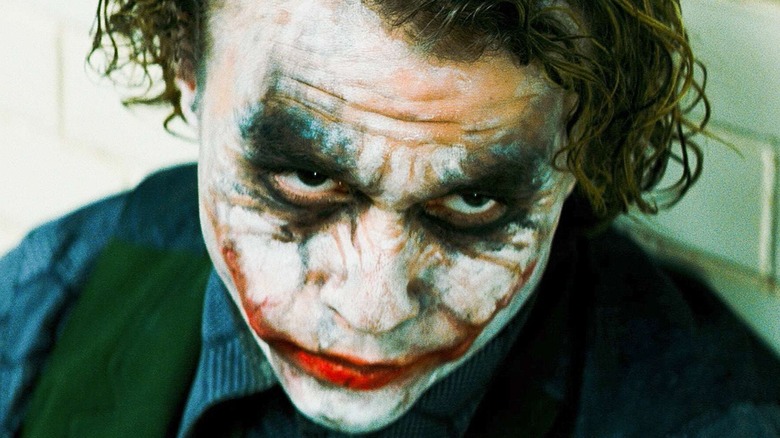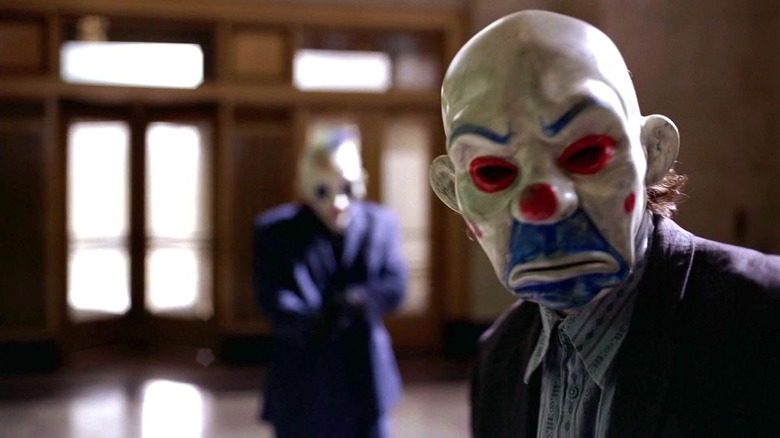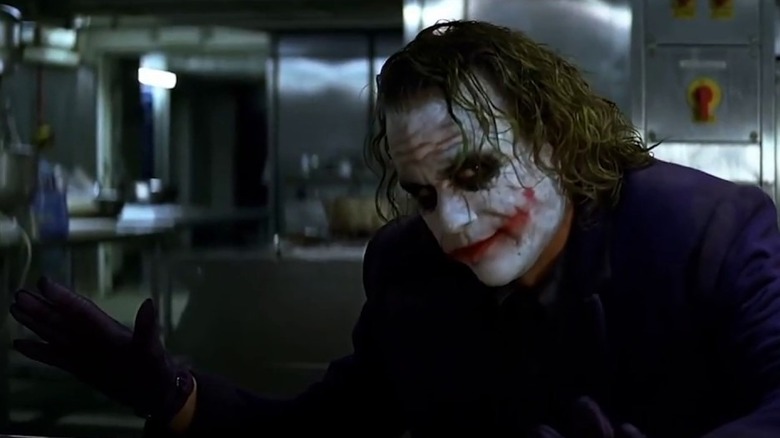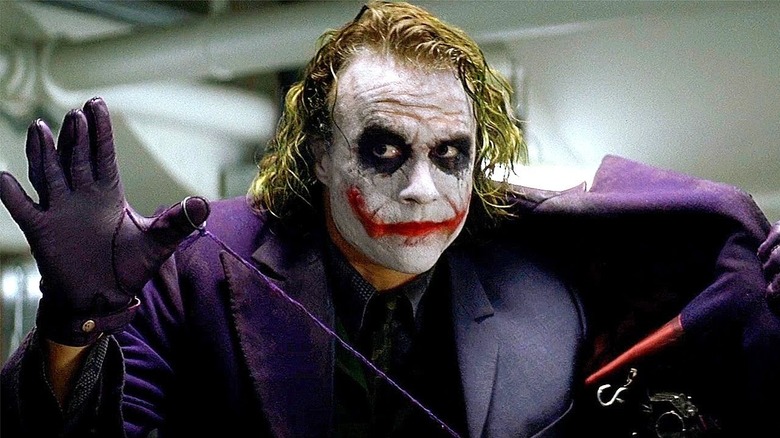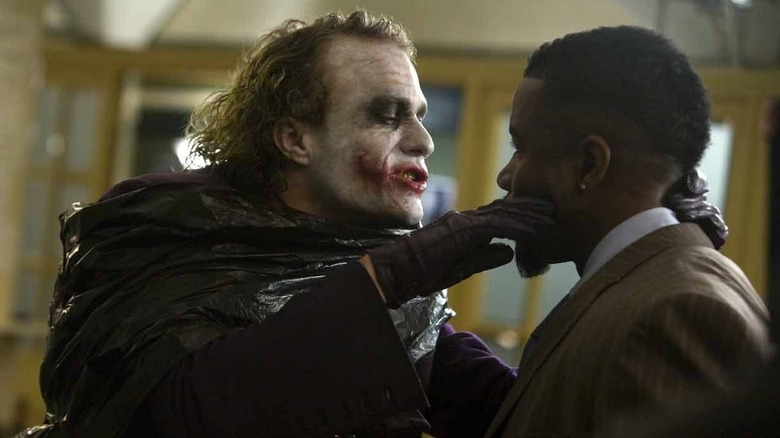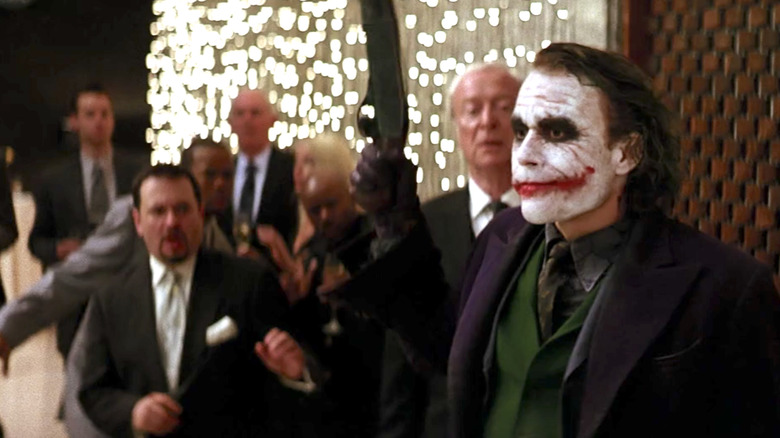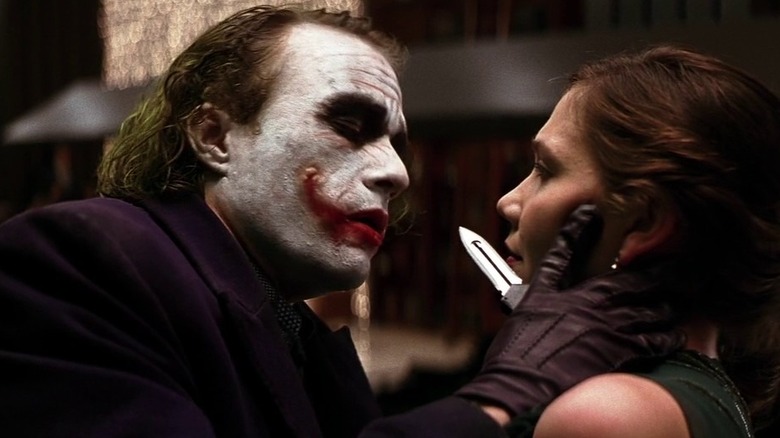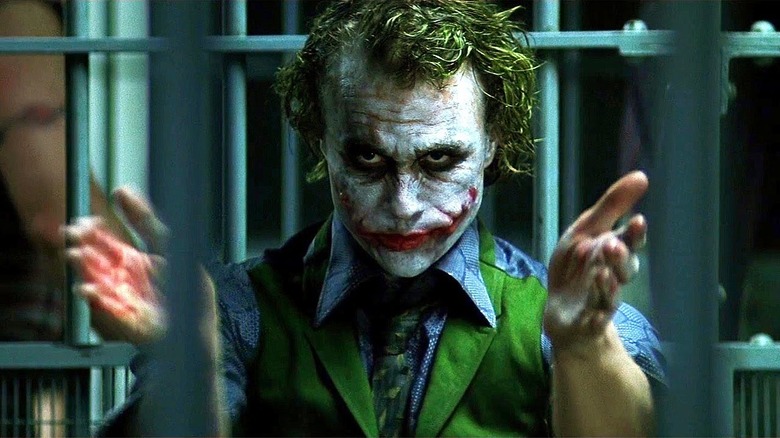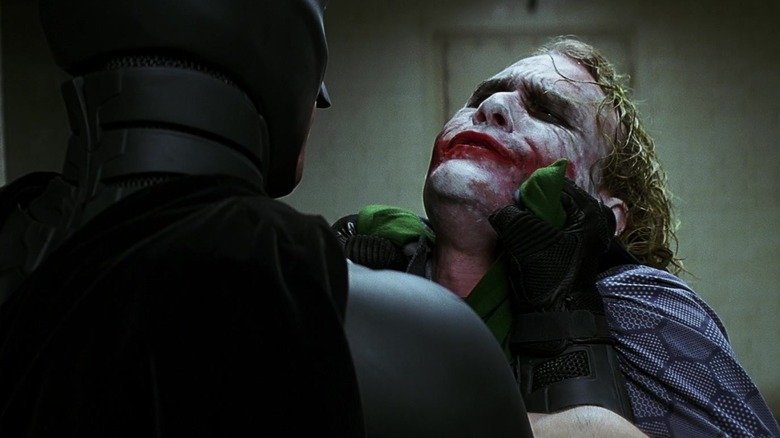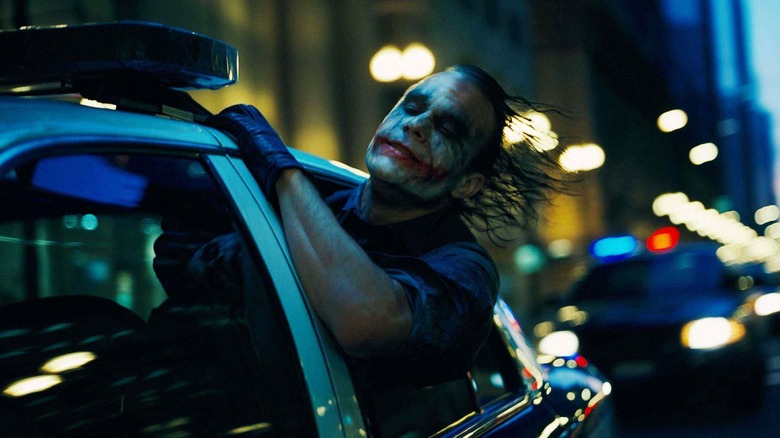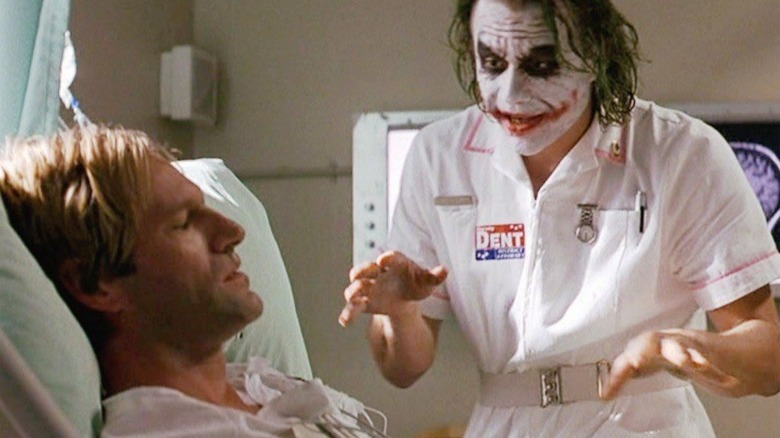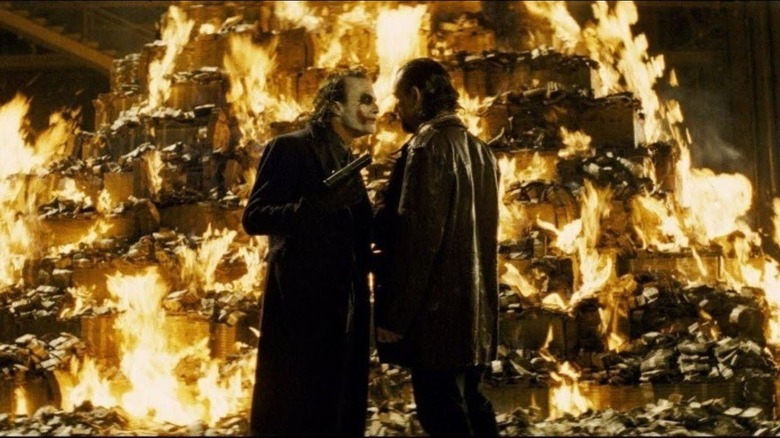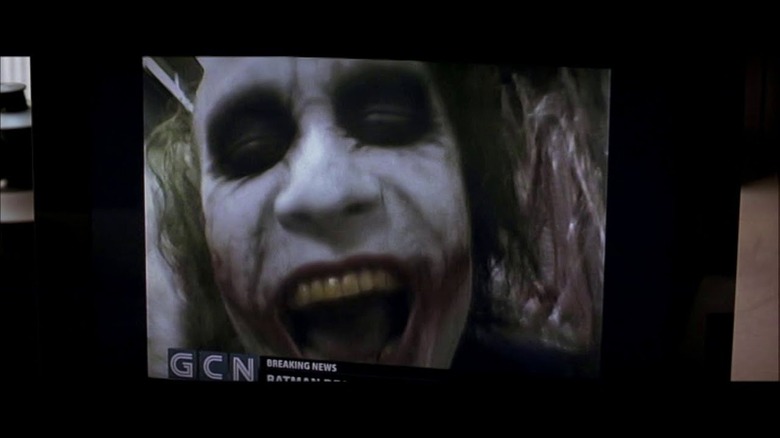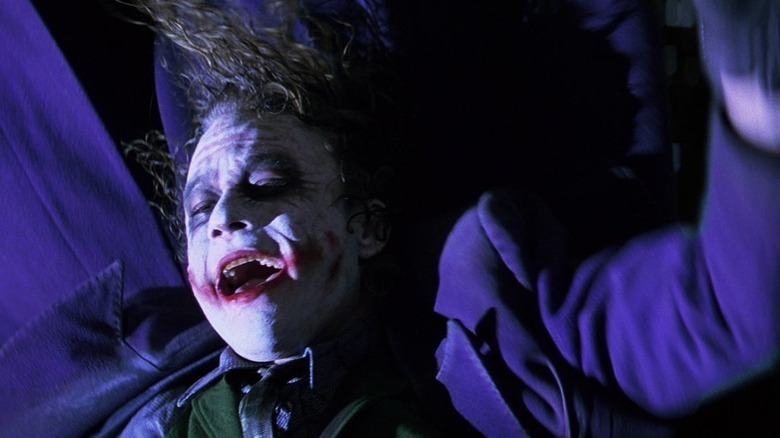Joker's Most Sinister Moments In The Dark Knight Ranked
To say that superhero movies are in vogue right now would be a staggering understatement. But while the genre is crushing the box office, critical acclaim is harder to come by. Very few superhero movies have managed to win major awards — but chief among the ones that have is Christopher Nolan's 2008 crime epic "The Dark Knight." Ostensibly a movie about Batman (Christian Bale), "The Dark Knight" is dominated by its main villain, the chaotic Joker. Heath Ledger plays the role to such perfection, it won him an Oscar and became a benchmark for all future movie villains.
Much ink has been spilled dissecting and analyzing Ledger's Joker, a job made all the more difficult and tantalizing because of how little we truly know about the character. Bereft of a definite backstory or personal life, the Joker seems to exist solely to cause wanton destruction and make people question their own morals. To better appreciate this iconic villain, we're taking a look at his most sinister moments, ranked from the merely terrifying to the absolutely soul-shaking.
14. Eliminating his teammates
"The Dark Knight" starts out by introducing the Joker in the most twisted possible way. A group of unidentifiable thieves wearing clown masks conduct an elaborate heist on a bank controlled by the mob. As the operation continues, more details about the robbery are revealed, starting with the fact that it was planned by a man called Joker.
As they get closer to getting their hands on the bank's money, the robbers eliminate their own teammates. This, we learn, is also part of the Joker's plan: Each criminal thinks he'll get a bigger payday with less competition. In the end, only two robbers remain — which is when they're interrupted by the bank manager, who's wielding a shotgun.
The final two criminals take out the manager and get into a standoff over who should survive and get all the money. Suddenly, a bus busts through the bank wall, killing one of the robbers. The final crook kills the bus driver before finally revealing he's been the Joker all along. So ends a masterful plan orchestrated by a diabolical and merciless villain with absolutely no reserves of remorse.
13. The magic trick
The fact that the Joker dares to rob a bank funded by Gotham's most prominent mobs sends a seismic shockwave across the city's underworld. With the police also tracking their finances, the biggest bosses convene to discuss the safety of their money. This is when the Joker joins the party.
Though he's standing in front of the most feared men in Gotham, the Joker doesn't show the slightest hint of worry. Instead, he offers to show them a magic trick to break the tension. He proceeds to stick a pencil upright on a table. When a criminal walks up to him, the Joker slams the guy's head into the pencil so hard, it jams inside his skull, killing him instantly.
While everyone looks on in shock and disbelief, the Joker declares his magic trick complete and sits down. He might have only pulled a rabbit out of a hat, he's so placid. This casual stance towards a horrific act of violence is all the proof this room full of criminals needs to know they're dealing with a new type of menace that cannot be intimidated or controlled.
12. Twitching, squinting, and licking his lips
The mob meeting that the Joker interrupts acts as a crash course in understanding how his mind works. After killing a man with a pencil, he tries to put on a show of normalcy by joining the other mob bosses as if he was an invited guest. The criminals listen, spellbound, as the Joker speaks eloquently about their fear of the Batman and why their money launderer, Lau (Chin Han), can't be trusted. But then the Joker gets interrupted in the middle of his speech by one of the bosses. A twitch of annoyance crosses the character's face. He tries to continue with his monologue, but the twitching continues, and is soon joined by other irritated spasms.
These tiny movements reveal the Joker's true, terrifying nature, and the fact that it can't be smothered by a calm façade. Every time he licks his lips or squints or eyes, he's growing more and more excited by the idea of inflicting violence on others. He can pretend to be a typical bad guy, but not very well or for very long. That's how potent his cruelty and derangement truly is.
11. A jacket full of bombs
One of the most immediately noticeable things about Heath Ledger's excellent version of the Joker is how grimy and dissolute he looks, especially compared to past iterations of the character. While other Jokers pride themselves on their dapper appearances and flamboyant manners, Ledger's Joker looks outright dirty. This implies he doesn't particularly care about his personal well-being — a revelation he doubles down on at the end of the mob bosses' meeting.
Having had enough of the Joker's insolence, one boss orders his men to take the clown down. The Joker swiftly reveals that his jacket is strapped with bombs, ready to be activated with the pull of a single thread attached to his thumb. In this moment, the Joker proves what his disheveled appearance implies: He would cheerfully give up his own life in pursuit of his plans. This makes him a far more dangerous villain than any of the self-serving mob bosses he's prepared to steal from and blackmail.
10. The first scars story
After getting the entire Gotham mob scene riled up, the Joker has a target on his back and a $1 million price tag on his head. The hit on the Joker comes courtesy of Gambol (Michael Jai White), who particularly irked the mad clown by calling him a freak and interrupting him. The Joker's seemingly dead body is brought before Gambol, but this turns out to be the perfect trap: The Joker springs to life and gets his knife inside Gambol's mouth before his men can react. He proceeds to tell Gambol the chilling tale of how he got his scars: His alcoholic father carved a bloody smile onto his face in a drunken rage.
The Joker's twitchy mannerisms go into overdrive in this moment, which dials the tension all the way up. Before Gambol can react to this story, the Joker slashes his face and drops the feared mob boss right in front of his men. Thus, the Joker comes one step closer to eliminating everyone on his enemies list — and driving Gotham to the brink.
9. Invading the party
Heath Ledger's turn as the Joker is so mesmerizing, it can be difficult to remember he's not the main character of the movie — or even the secondary lead, for that matter. Those positions belong to Bruce Wayne and district attorney Harvey Dent (Aaron Eckhart), who are both on a quest to rid Gotham City of crime and corruption. To that end, Bruce throws Harvey a fundraiser for his election campaign. Unbeknownst to Bruce, the Gotham mob bosses have already agreed to allow the Joker to take down the Batman in return for half their money. Thus, the Joker invades Bruce's fundraiser in search of Harvey Dent, whom he sees as a means of getting to Batman.
The Joker announces his presence by firing off a shotgun, plunging the party into abject terror. The sheer force of his malevolence affects every guest at the party: They quiver like children in the presence of a monster. The Joker walks casually among them, swilling champagne and nibbling from others' plates. This insouciance makes him all the more terrifying — he could be taking a stroll in the park, except for the fact that he's flanked by armed henchmen. No one can tell what he'll do next, but it's clear he's capable of anything.
8. The second scars story
After invading Bruce Wayne's fundraiser, the Joker and his cronies terrorize the guests. But Rachel Dawes (Maggie Gyllenhaal) isn't cowed by their behavior. She knows to keep the peace long enough to allow Bruce to return as Batman. When Rachel interrupts the Joker's fun, he becomes intrigued and turns his full attention to her. Naturally, Rachel winces as the villain gets up close and tells her yet another chilling origin story about his scars. This time, the Joker alludes to a marriage buried in his past. He carved the scars himself in solidarity with his wife, who was similarly disfigured when she couldn't repay her gambling debts.
As twisted as this story is, what makes it particularly head-turning is that it reveals the Joker has lied about his backstory. Rachel and Gambol hear two entirely different explanations of his scars, either of which might be true — if one of them is true at all, that is. The Joker could be making these tales up on the spot. This shrouds his past in mystery and makes the villain of the present even more elemental and chaotic. We cannot hope to truly understand this Joker, no matter how hard we might try.
7. Clapping for Gordon
Many characters, including Batman, contemplate doing immoral things during particularly low points in "The Dark Knight." But one character stands steadfast as a symbol of strength and righteousness: Police Lieutenant James Gordon (Gary Oldman). He's so devoted to justice, he orchestrates his own fake death in order to finally catch the Joker. This trap takes a toll on Gordon's family, but it succeeds. With the demented clown in lockup, Gordon receives praise from his superiors, as well as a promotion to commissioner. While the police precinct applauds him, Gordon is suddenly discomfited to realize that the Joker is also clapping, a sardonic smile stretched across his face.
This is one of the most purely unsettling things the Joker does in the whole movie. He's trapped in the most heavily guarded location in Gotham, yet his actions and expression indicate he still holds all the cards. What does he know? What is he planning? What's coming next? Neither the audience nor Gordon knows for sure — and that's what makes this moment so chilling.
6. Taunting Batman during the interrogation
After operating from opposite sides of the chess board during the first half of the movie, the Joker and Batman finally come face-to-face in a police interrogation room. Batman needs to find out where the Joker's men have taken the kidnapped Harvey Dent, which forces the Caped Crusader to confront the mad clown personally. This is easier said than done. It's immediately clear that the Joker is not on the back foot at all, despite being locked inside a room with Batman himself. As the entire police force watches, the Joker taunts Batman about his views on morality and mocks him for believing the people of the city see him as anything more than a useful freak.
The tension reaches new heights when the Joker reveals his men have also kidnapped Rachel, and that there's only enough time left to save one of them. An enraged Batman starts beating up the Joker, who merely laughs in the hero's face. "You have nothing, nothing to threaten me with," the villain mutters. "Nothing to do with all your strength." The awful truth is, he's right.
5. Goading the police officer
All through his time in police custody, the Joker maintains his puzzling confidence. This indicates he has some sort of trick up his sleeve that secretly gives him the upper hand. Said trick is revealed in all its terrible glory after Batman and Gordon set off to find the kidnapped Harvey and Rachel.
The Joker is left alone in the interrogation room with a single police officer. While the officer tries to maintain professional composure, the Joker begins a psychological assault. He brings up the fact that he's murdered many of the officer's friends and colleagues, then gloats about knowing their true, cowardly natures better than anyone else. The Joker knows just which buttons to push to make the officer finally snap and attempt to assault him, which is just what he needs to make his escape from the precinct.
In this scene, the Joker demonstrates why he's such a unique threat to Gotham. While other villains rely on physical strength or sheer intelligence, the Joker possesses unique insight into people's minds, which allows him to bring out their worst impulses. He uses this skill to simultaneously gain the upper hand and drag others down to his violent and depraved level.
4. Turning Harvey Dent
Among its many subplots, "The Dark Knight" tells the story of one man's moral descent. Harvey Dent starts out as Gotham's champion. Everyone admires him — even Batman — for his unshakeable sense of justice and dogged determination to rid the city of corruption. But not even a man of Harvey's moral fiber can withstand the Joker's psychological onslaught.
It starts when the Joker kidnaps Rachel, the love of Harvey's life, and forces the hard-working district attorney to listen as he kills her. Later, as Harvey is still reeling from this trauma, the Joker visits him in the hospital. Bit by bit, the madman shows Harvey that his idea of the world is built on shaky ground, destined to crumble under the realization that terrible things happen to good people and bad people often get away with their crimes. Thanks to these expert manipulations, Harvey gives up his moral principles and becomes Two-Face, who decides what counts as justice by literally flipping a coin. Thus, the Joker transforms an upright man into a vengeful monster.
3. Burning the money
Despite proving again and again that he is not a man to be trifled with, Gotham's underworld, police force, and Caped Crusader keep on underestimating the Joker. They're just too focused on his bizarre clothes, clown makeup, and fondness for couching everything he does with jokes and amusing diversions. After all, the guy willingly calls himself "Joker" — how scary can he really be?
The answer to that question arrives when a Chechen mob boss (Ritchie Coster) gives the Joker the money he was promised for bringing Lau in from the police station. In front of the mob boss' stunned eyes, the maniacal clown burns his part of the money. For once, the Joker drops his comedic façade. There is no trace of a smile on his face as he muses, "This town deserves a better class of criminal." The man everyone has mistaken for a laughing jester proves just how serious he is about mayhem in this moment. Everyone and everything will burn together if he gets his way, and no amount of riches can stop him.
2. The tape
The biggest mistake everyone makes in "The Dark Knight" is failing to understand the Joker's desire for pure chaos. This keeps the villain one step ahead throughout the entire movie — no one can predict what he'll do next, or how far he'll go. Case in point, after he decides to go after Batman with the full backing of the mob, the Joker makes an official declaration of war in the most horrific manner possible. He kidnaps a Batman copycat who's been trying to help the Caped Crusader without elite resources or training, executes him, and hangs him in a public place with a smile carved across his face.
But the worst part of this whole affair is the video recording the Joker makes of it. In the vicious tape, which is sent to local news stations, the Joker can be heard taunting and torturing the copycat for daring to attempt heroism in a city like Gotham. The sickening content of the video is enhanced by its frenzied, haphazard camerawork. It truly looks like something the Joker made on his own. This lack of refinement makes it clear that the Joker likes to get his hands dirty, and that he doesn't care about keeping up slick mob appearances — he's just in it for the carnage.
1. The Joker's final laugh
The Joker's crimes finally catch up to him towards the end of "The Dark Knight." It's a near thing, though: As Batman fights through an army of henchmen and confused police officers to reach the Joker, the vicious villain has already put his plans in motion. As he reveals in a hauntingly calm P.A. announcement, he's packed two ferries full of explosives. One carries civilians, while the other carries prisoners. If the passengers of one ferry choose to blow up the other, he'll let them live. It's a heinous plan — but it hits a snag when both ferries refuse to execute the other to save their own lives. This is a major blow to the Joker's worldview: Gotham is not, in fact, beyond saving. Batman further ends the Joker's mind games by sending him plummeting from a skyscraper.
In this moment, with oblivion only seconds away, the Joker begins laughing maniacally. He welcomes death if it means forcing Batman to kill someone. The Dark Knight does manage to prevent the Joker's death with a well-aimed grappling hook, but it hardly matters. In this moment, the Joker has won — and he knows it. His actions have forced Gotham City, Harvey Dent, and Batman himself to peer into the abyss, and as a result, they will never be the same.
